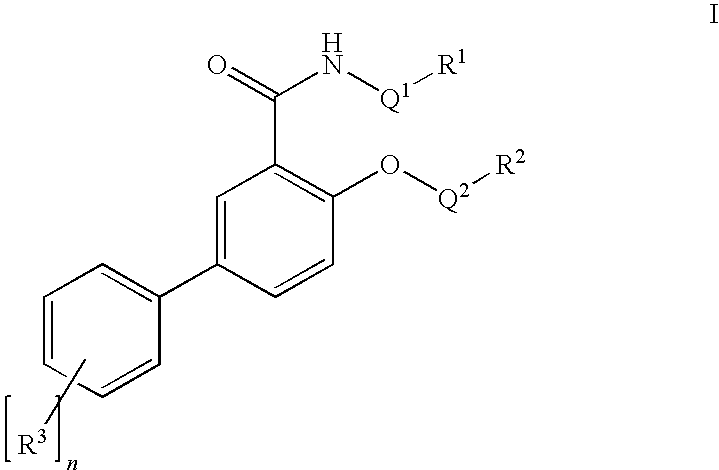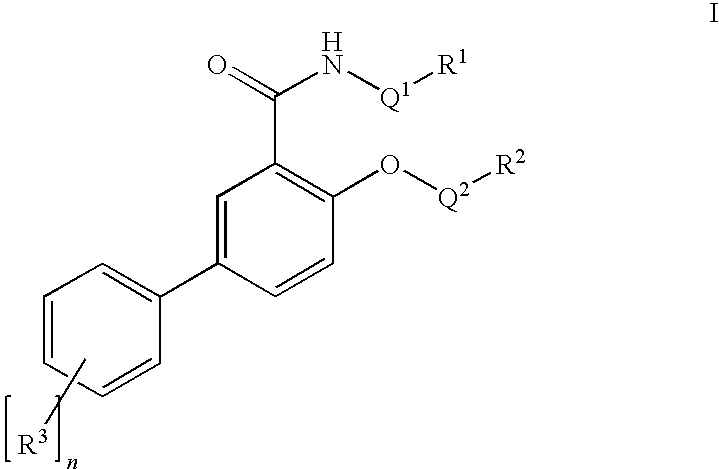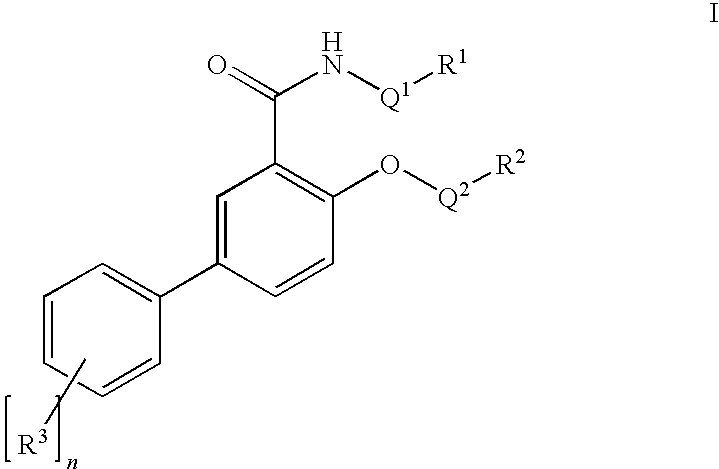Salicylamide derivatives as nicotinic alpha 7 modulators
a technology of alpha 7 and salicylamide, which is applied in the field of positive allosteric modulators of the alpha 7 nachr subtype, can solve the problems of limiting the usefulness of agonists as drugs, and achieve the effect of enhancing cognition
- Summary
- Abstract
- Description
- Claims
- Application Information
AI Technical Summary
Benefits of technology
Problems solved by technology
Method used
Image
Examples
example 1
[0200]Methyl 5-iodosalicylate (TCI, 4.9 g, 17.5 mmol), cyclopropane carbinol (Aldrich, 1.15 g, 16 mmol) and triphenylphosphine (Aldrich, 5.45 g, 21 mmol) were dissolved in anhydrous toluene (50 mL) and cooled to 0° C. Diisopropyl azodicarboxylate (Aldrich, 4.1 mL, 21 mmol dissolved in 20 mL of toluene) was added dropwise to the solution above over 15 minutes. After stirring at ambient temperature for 3 days, the mixture was diluted with hexane and directly loaded onto a pad of silica. The desired ether (3, 4.63 g, oil) eluted with an ethyl acetate 5-20% gradient in hexanes and displayed spectroscopic properties consistent with the desired material.
[0201]Ether 3 (3.0 g, 9.0 mmol), 4-methoxy-2-methylphenyl boronic acid (Combi-Blocks, 1.65 g, 9.9 mmol), cesium carbonate (Aldrich, 7.3 g, 22.5 mmol), ethanol (5 mL), water (25 mL) and toluene (70 mL) were vacuum purged with nitrogen while heating. Tetrakis(triphenylphosphine) palladium (Strem, 1.04 g, 0.9 mmol) was added and the mixture w...
example 2
[0203]Ester 6 (1.6 g, 4.1 mmol) was dissolved in tetrahydrofuran (60 mL) and methanol (5 mL). The solution was plunged into an ice-bath and treated with lithium hydroxide [(400 mg, ca. 10 mmol) dissolved in water (20 mL)] and stirred at ambient temperature overnight. The volatiles were removed from the mixture and the residue was partitioned between water (50 mL) and ethyl ether (2×30 mL). The aqueous layer was quenched with 10% aqueous acetic acid and extracted with ethyl acetate (3×60 mL) and then stored over anhydrous sodium sulfate. The desired acid was obtained (7, 1.4 g, mp 125-126° C., MS m / z for parent ion M−1 377) following filtration and removal of the volatiles and it displayed spectroscopic properties consistent to the proposed structure. The acid (255 mg, 0.67 mmol) was dissolved in N-methyl-2-pyrrolidinone (4 mL) and treated with carbonyl diimidazole (108 mg, 0.67 mmol, added in one portion). The solution was stirred vigorously at ambient temperature for 10 minutes. Am...
example 3
[0206]Ester 5 (2.23 g, 6.8 mmol) was dissolved in tetrahydrofuran (60 mL) and methanol (5 mL). The solution was plunged into an ice-bath and treated with lithium hydroxide [(860 mg, ca. 20 mmol) previously dissolved in water (20 mL)] and stirred at ambient temperature overnight. The volatiles were removed from the mixture and the residue was partitioned between water (50 mL) and ethyl ether (2×30 mL). The aqueous layer was quenched with 10% aqueous acetic acid and extracted with ethyl acetate (3×60 mL) and then stored over anhydrous sodium sulfate. The desired acid was obtained (11, 1.66 g, mp 139-140.5° C., MS m / z for parent ion M+1 313) following filtration and removal of the volatiles and it displayed spectroscopic properties consistent to the proposed structure. The acid (314 mg, 1.0 mmol) was dissolved in N-methyl-2-pyrrolidinone (4 mL) and treated with O-(7-azabenzotriazol-1-yl)uronium hexafluorophosphate (4210 mg, 1.1 mmol) under N2. The solution was immediately treated with ...
PUM
| Property | Measurement | Unit |
|---|---|---|
| Rg | aaaaa | aaaaa |
| Rg | aaaaa | aaaaa |
| Rg | aaaaa | aaaaa |
Abstract
Description
Claims
Application Information
 Login to View More
Login to View More - R&D
- Intellectual Property
- Life Sciences
- Materials
- Tech Scout
- Unparalleled Data Quality
- Higher Quality Content
- 60% Fewer Hallucinations
Browse by: Latest US Patents, China's latest patents, Technical Efficacy Thesaurus, Application Domain, Technology Topic, Popular Technical Reports.
© 2025 PatSnap. All rights reserved.Legal|Privacy policy|Modern Slavery Act Transparency Statement|Sitemap|About US| Contact US: help@patsnap.com



